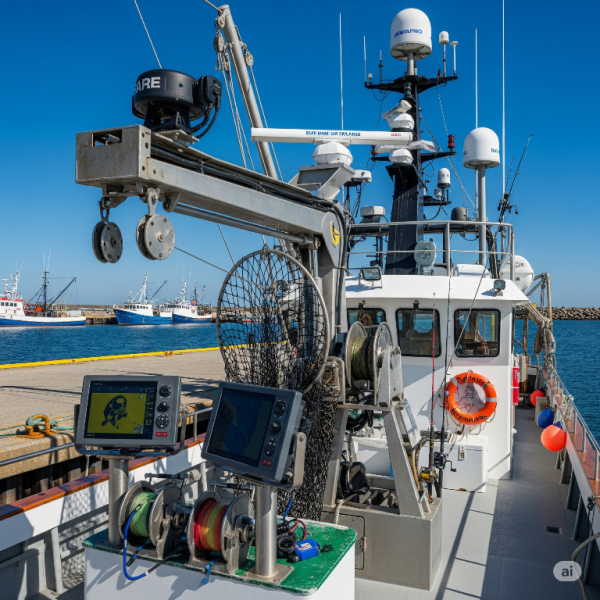
Modern fishing vessels are far more than just boats; they are sophisticated platforms packed with a wide array of crucial equipment. This gear ensures safe navigation across vast oceans, facilitates vital communication, enables authorities to monitor fishing activities, and, of course, allows for efficient and effective fishing operations. Let’s cast a line into the key pieces of equipment commonly found on board:
1. Navigational Equipment: Charting the Course and Ensuring Safety
Precise navigation is paramount at sea. Here’s what helps a fishing vessel find its way and stay safe:
- GPS (Global Positioning System): A fundamental tool providing accurate vessel position (latitude and longitude), speed, and course. It’s essential for voyage planning, marking productive fishing spots, and safe return to port.
- Radar: Used to detect other ships, landmasses, adverse weather (like storms), and other objects around the vessel, especially in low visibility conditions (night, fog). Crucial for collision avoidance.
- Echosounder/Fish Finder: This device uses sound waves to measure water depth beneath the vessel and, critically, to detect the presence of fish and map the seabed contours. Indispensable for locating schools of fish.
- Compass (Magnetic and Gyro): Indicates magnetic north, helping the master steer the vessel on the desired course. Larger vessels often have a gyro compass, which is more accurate and unaffected by the ship’s magnetic field.
- Nautical Charts (Paper and Electronic/ECDIS): Traditional paper charts are still used, but many modern vessels utilize ECDIS (Electronic Chart Display and Information System), which displays digital nautical charts integrated with other navigational information.
- AIS (Automatic Identification System): Automatically transmits and receives the vessel’s identity, position, speed, and course to and from other AIS-equipped vessels and shore stations. This significantly enhances situational awareness and helps prevent collisions.
- Speed Log: Measures the vessel’s speed through the water.
- Anemometer: Measures wind speed and direction, important for safety and voyage planning.
- Barometer: Measures atmospheric pressure, aiding in forecasting weather changes.
- Weather Facsimile (Weather Fax): Receives weather maps and forecasts via radio, assisting the master in planning safe voyages and avoiding severe weather.
2. VMS (Vessel Monitoring System): Eyes on the Ocean
The Vessel Monitoring System is a critical tool for fisheries management and regulatory compliance:
- VMS Transmitter: A device installed on the vessel that automatically transmits data—such as the vessel’s position, time, speed, and course—to fisheries monitoring centers via satellite.
- Monitoring and Surveillance: Ensures vessels comply with fishing regulations, such as staying out of restricted zones.
- Fisheries Management: Provides data for fish stock analysis and sustainable fisheries resource management.
- Security: In some instances, VMS can assist in Search and Rescue (SAR) operations.
- Combating Illegal Fishing: An important tool for detecting Illegal, Unreported, and Unregulated (IUU) fishing activities.
3. Radio and Communication Equipment: Staying Connected
Reliable communication is vital for operational efficiency, safety, and crew welfare:
- VHF Radio (Very High Frequency): The most common short-range voice communication tool used between ships, with shore stations, and for distress calls (Channel 16). Modern VHF radios often include DSC (Digital Selective Calling) for sending digital distress alerts with position information.
- HF Radio (High Frequency)/SSB (Single Side Band): Used for long-range voice communication, allowing vessels to communicate with land or other vessels hundreds or even thousands of miles away.
- Satellite Telephone and Internet: Provides global voice and data communication, essential for operational communications, sending reports, and crew welfare in areas without conventional mobile signals.
- EPIRB (Emergency Position Indicating Radio Beacon): A vital safety device. When activated in an emergency (manually or automatically if the vessel sinks), it transmits a distress signal with the vessel’s position to rescue satellites.
- SART (Search and Rescue Transponder): A device that responds to radar signals from SAR ships or aircraft, helping them pinpoint the location of a vessel in distress.
- Navtex (Navigational Telex): Automatically receives Maritime Safety Information (MSI), such as navigational warnings, weather forecasts, and other important news in text format.
4. Other Essential Equipment: Powering and Facilitating the Catch
Beyond navigation and communication, a host of other systems are crucial:
- Main and Auxiliary Engines: The primary power source for propulsion and for the vessel’s electrical systems.
- Generator Set (Genset): Produces electricity for all equipment on board.
- Fishing Gear: Varies widely depending on the type of vessel and target species. This includes nets (e.g., purse seines, trawls, gillnets), lines (e.g., longlines, pole and line), traps (pots), along with winches and hydraulic equipment to operate them.
- Refrigeration/Freezer/Cold Storage: Essential for preserving the catch and keeping it fresh until it reaches land.
- Pumps: Used for various purposes, including bilge pumps (to remove water that enters the vessel), seawater pumps, and fuel pumps.
- Safety Equipment: In addition to EPIRBs and SARTs, this includes life rafts/lifeboats, life jackets, ring buoys, fire-fighting equipment, and first-aid kits.
- Navigation Lights and Deck Lighting: Essential for night operations and for signaling to other vessels.
- Sonar: Some modern fishing vessels use more advanced sonar for wider-area seabed mapping and fish detection compared to standard echosounders.
Each piece of this equipment plays a critical role in supporting safe navigation, efficient fishing operations, and compliance with regulations. As technology advances, fishing vessels continue to be equipped with increasingly sophisticated and integrated systems, all aimed at making life at sea safer and fishing more sustainable.

